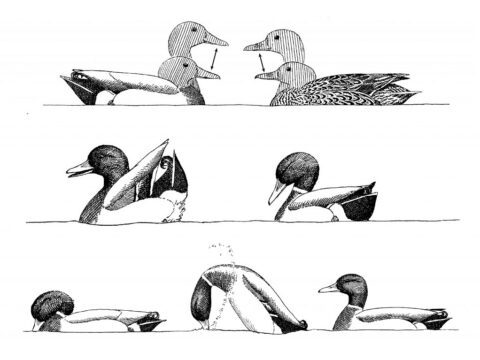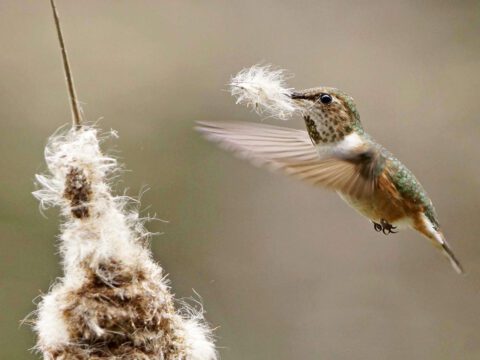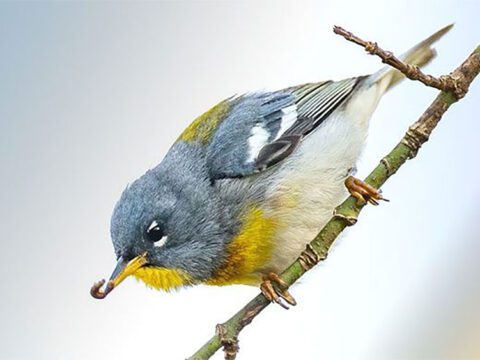5 Great Features of the Warbler Guide App That Won’t Fit in Any Book
By Hugh Powell
May 29, 2015
Update: in early 2017 the Warbler Guide app became available for Android devices, in addition to iOS devices.
Warblers are a fascinating mix of beauty and frustration: eye-popping color and sweet song, along with the ability to disappear behind the smallest of leaves and to molt into head-scratching plumages each fall. The Parulidae finally got the field-guide treatment they deserved in 2013—and we loved The Warbler Guide’s mix of information and innovation.
But authors Tom Stephenson and Scott Whittle didn’t stop there. The Warbler Guide app followed in late 2014. The app is far more than a straight repackaging of the printed content. It does feature a huge amount of information from the book—all of the photos, the quick finders, the ID text, comparison species, ageing and sexing guides, and song info—but it adds imaginative and really useful functions that are only possible in a digital format. Here’s a rundown of what the app lets you do:
1. Compare 2 species from any angle using 3-D models
 You had me at “3-D models.” This is the kind of thing we used to dream about when flipping through field guides—a way to free those illustrations from their static, side-on poses and rotate an entire bird left, right, up, down, until it was in the exact position you saw it in (usually, for me, a 3/4 view of the belly and undertail coverts).
You had me at “3-D models.” This is the kind of thing we used to dream about when flipping through field guides—a way to free those illustrations from their static, side-on poses and rotate an entire bird left, right, up, down, until it was in the exact position you saw it in (usually, for me, a 3/4 view of the belly and undertail coverts).
These rotatable views are probably the coolest feature of the app—especiallysince you can do it with two birds at a time to compare exactly what’s different.
Put it this way: we now live in a world where a Golden-winged Warbler can dance to a Kanye song.
How-to: From the species finder, select a warbler species. When its page opens, swipe until you see the bird in profile, then tap the “3D” icon that appears in the upper right of your screen. To compare two similar species, select a comparison species, make sure you’re on the profile view, and then tap the 3D button to bring up a split screen. Then rotate to your heart’s content.
2. Narrow down using plumage and song clues simultaneously, using the Filter
Filtering tools are a pretty common way for digital field guides to help you find what you’re looking for. But one thing makes the Warbler Guide’s filter special: you can add together plumage and song clues into a single filtered list of possibilities. This works nicely for the classic warbler-viewing experience, where you hear the bird singing but strain to get a clear view of anything more than the belly. For example, if your warbler is camped out behind a leaf and all you can get is a black back and a rising song, the filter can still narrow it down to just one bird.

How-to: tap the “Filter” icon in the top right of your screen. On an iPad, a Filter tray will slide out from the left side of the screen. On an iPhone, the Filter tray will take over the whole screen. Tap on a part of a bird to select the color or markings you saw, and/or tap to select the sound qualities you heard. On an iPad, the warbler list will update as you select items; on an iPhone just tap on the Filter icon again to show the list of possible species.
Tip: keep to a low number of filtered items at first. This will narrow the list of possibilities but will reduce the chance you’ll wind up with no choices (for instance, if you judge a color or sound differently than the app’s authors did). You can always add items to the filter as you go.
3. Listen to lots of song recordings—each one with a spectrogram
You do at least 50 percent of your warbler watching with your ears. Songs help you zero in on a target species, or find those elusive rascals as they flit from the top of one leaf to the top of the next. Both the Warbler Guide book and the app go the extra mile to provide excellent help with learning songs.
One of the great benefits of an app over a book is the ability to play sounds rather than resort to written evocations such as “sweet, sweet, sweet, I’m so sweet.” (I am a big fan of the Warbler Guide’s haiku-esque song descriptions, but actual recordings are still preferable.) The Warbler Guide app goes further, compiling up to a dozen song variations and chip notes for each species (recordings are from our own Macaulay Library). And each one comes with its own spectrogram—a tried-and-tested but criminally underused tool invented by bioacousticians. A spectrogram is a graph of pitch versus time—it lets you use your eyes to learn sounds. (If you’re new to spectrograms, our Bird Song Hero game is a fun introduction to them.)
How-to: You can play songs straight from the list of warbler species, or you can play them from the Songs tab in each species profile. Tap the musical-note icon that appears under the images of male warblers. This brings up a list of calls and songs. Tap on the carat at the top to display a detailed description of the song’s makeup. Tap on an entry in the list to play that song. The text at the top changes to display the spectrogram and text specific to that recording.

4. Not just similar species—similar-sounding species
Going all the way back to the great Peterson guides, one of the most useful parts of a field guide is the similar species section. This is where the reader gets to lean on the expertise of the author, learning both which species you should worry about and how you tell the difference. The Warbler Guide app can help you with similar-looking species. But it goes further, pointing out similar-sounding species as well. Their explanations are incredibly specific, too—similar-sounding species are compared on a song-by-song basis.
How-to: To see comparison songs, you’ll need to choose a warbler species and go to its species account. Tap the Songs tab and select a song. A list of species with similar songs appears below. Tap to play a song in this list, and the spectrogram appears along with text telling you how this song differs from the song you’re comparing it to.
5. Learn a song’s details by slowing it down to half-speed
Guitarists have for years been slowing down recordings so they can learn the secrets of fleet-fingered heroes like Stevie Ray Vaughan or Bonnie Raitt. Now it’s our turn. And because we live in a digital age, it’s even possible to slow down a recording without lowering its pitch. The notes sound the same, they just come at you slower, so you can concentrate on the details. For reference, musicians pay around $15—more than the Warbler Guide—for an app whose sole function is slowing down music. That’s with no recordings, no expert text, no colorful, rotatable warblers. This feature is yet another example of how the Warbler Guide authors went above and beyond expectations with this app.
How-to: From any song list, choose a song and press the Play icon. The song will begin to play, but you’ll also see three new buttons appear. Tapping the middle one (1/2) will start the song over and play it at half speed.
A few final notes about the app
The Warbler Guide app is only available on iOS devices at present (update: an Android version of the app launched in early 2017). The app works just fine on an iPhone, although the larger screen of an iPad makes it easier to use features like the Filter. According to Stephenson, the sweet spot in terms of screen size vs. portability is an iPad Mini or an iPhone 6+. The text is small enough on an iPhone that older users (such as this reviewer) may find themselves reaching for their glasses (although it’s still more readable than the text in the second edition Sibley guide). And finally, you’ll need to get used to the fact that the app does not have a search bar. Fortunately, the app is limited to just warblers; it’s easy just to scroll down the alphabetic list of warblers to the one you’re interested in.
Bonus: Video tutorials can help you find these hidden features and more
We highly recommend the Warbler Guide app to anyone with an interest in seeing, hearing, and learning the 50-odd warbler species in North America. Do bear in mind, however, that—like the book—the app has so much packed into it that it can be hard to find your way to all of its features. To help users deal with this, the authors prepared some helpful video demonstrations to get you up and running.
As Stephenson and Whittle are fond of saying, Happy Warblering!
More about warbler identification:
- Review: New Warbler Guide Practically Sings With Information, Innovation
- How to Listen to Bird Song—Tips From the Warbler Guide Authors
- Video: Our expert tips for finding and enjoying warblers
- The Warbler Guide at Princeton University Press
(Warbler Guide screen images courtesy Tom Stephenson/Scott Whittle.)

All About Birds
is a free resource
Available for everyone,
funded by donors like you
American Kestrel by Blair Dudeck / Macaulay Library




